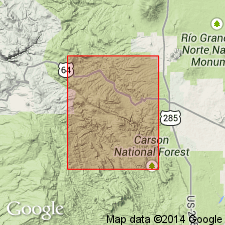
- Usage in publication:
-
- Biscara member
- Modifications:
-
- Original reference
- Dominant lithology:
-
- Sandstone
- Tuff
- Conglomerate
- Breccia
- AAPG geologic province:
-
- San Juan basin
Summary:
Pg. 3, 38, 44, pl. 1. Biscara member of Los Pinos formation. Interlayered tuffaceous sandstone, tuff, conglomerate, and volcanic flow breccia. Conglomerate, with fragments of gray, brown, and dark-red andesite and quartz latite, graywacke, and tuff forms most of the unit. Maximum observed thickness 650 to 700 feet on west side of Canon del Agua. Successively overlapped from south to north by Jarita basalt member (new), an associated gray tuff, and Cordito member (new). Age is considered Miocene(?) or Pliocene(?). Name credited to Butler (unpub. dissert.).
Named from exposures in Biscara Canyon about 1 to 5 mi from its mouth, Rio Arriba Co., [Carson National Forest area], central northern NM (Butler). These strata of the type locality, however, are here included in Biscara-Esquibel member (new). Mapped in lower Tusas Valley east of Tusas Canyon, from 1.3 mi north of Petaca to a point about 3.5 mi north-northwest of Las Tablas, Las Tablas quadrangle, Rio Arriba Co., [Carson National Forest area], central northern NM.
Source: US geologic names lexicon (USGS Bull. 1200, p. 351).

- Usage in publication:
-
- Biscara Member†
- Modifications:
-
- Abandoned
- AAPG geologic province:
-
- San Juan basin
Summary:
Abandoned as a member of Los Pinos Formation. Rocks included in it are reassigned to the Cordito and Esquibel Members of Los Pinos, to El Rito Formation, Conejos? Formation, and younger intermediate-composition. The rhyolitic tuffaceous beds, rhyolitic tuffs, and units containing gray aphanitic rhyolite clasts are assigned to Cordito. The Precambrian-clast conglomerates are divided between Esquibel and El Rito, depending on stratigraphic position above or below Treasure Mountain or Masonic Park Tuffs. The "intrusive" rocks of Butler are actually extrusive intermediate-composition flow breccias similar to the Conejos.
Source: GNU records (USGS DDS-6; Denver GNULEX).
For more information, please contact Nancy Stamm, Geologic Names Committee Secretary.
Asterisk (*) indicates published by U.S. Geological Survey authors.
"No current usage" (†) implies that a name has been abandoned or has fallen into disuse. Former usage and, if known, replacement name given in parentheses ( ).
Slash (/) indicates name conflicts with nomenclatural guidelines (CSN, 1933; ACSN, 1961, 1970; NACSN, 1983, 2005, 2021). May be explained within brackets ([ ]).

